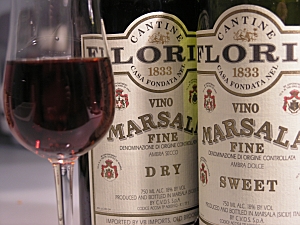Marsala Wine Production
 June 25, 2009
June 25, 2009
There isn’t really much to be said for the production of Marsala wines so this will be a short discussion on the subject. Alternatively, you can learn about wine made in Marsala, Sicily in my post Marsala Wine: Captialism’s Bastard Child. One reason there’s not a big hoopla about it is because it was a late comer to the fortified wine trend in the. 18th century. By the time the wine became trendy, Port, Sherry and Madeira already had a strong foothold in the fortified wine market. But you can think the late comer John Woodhouse for exposing Marsala wines to the world.

I haven’t had the pleasure of tasting much fine Marsala. Typically what I sample is from dipping my middle finger in a chicken Marsala as I cook. But like I’ve said before, that’s not the real thing. Not real in the sense that it’s not a fine wine that one would sip as an after dinner drink or an apéritif. I wouldn’t go so far as to call it a dessert wine, however, as it comes in both dry and sweet styles.
There are three main grapes harvested for production and they are Catarratto, a white wine grape that is second only to Sangiovese in its plantings in Italy. It produces full-bodied wines with distinct lemon notes; Grillo, which is another white wine grape, and adds intense fruit aromatics; and Inzolia, which provides nutty flavors.
Like the other fortified wines, grape spirits are added to the must during production. It is introduced to the must during fermentation when the appropriate sugar levels are reached. When making amber Marsalas (Ambra Marsalas) Mosto Cotto, a concentrated cooked must is added to achieve proper sweetness. Other times, a late-harvest overripe must called Sifone (from the Grillo grape) is added. It depends on the style being made as to which sweetener is added. This also applies only to the semi-sweet and sweet varieties of Marsala wine.
As I’m not one to repeat myself but so much I’ll direct you to the post in which the different styles are explained. Those styles of Marsala are here. Once the wine is ready for aging it goes through a Solera process before hitting the market for sale.
Although it is difficult to find, if you want to buy Marsala wine for drinking, look for one that says Superiore Riserva or simply Riserva on the label, a Vergine, or a Vergine Stravecchio Riserva. These are aged four, five and ten years, respectively, and are better suited as aperitifs than the Fine or Superiore Marsala wine.
Related posts:

 Posted in
Posted in 

